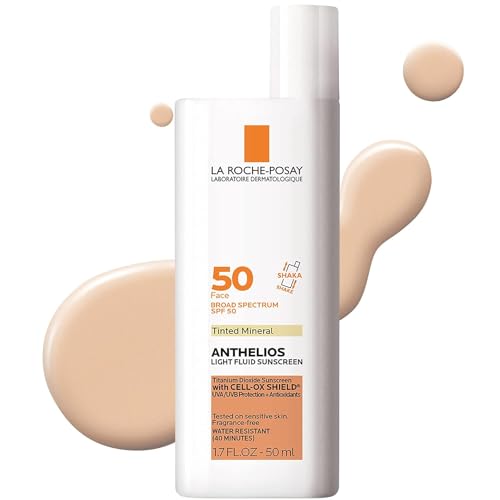Effectiveness of Tinted Sunscreens in UVL and VL Protection
Bridging this gap are tinted sunscreens, emerging as powerful tool in the fight against hyperpigmentation. Beyond their conventional role in shielding against ultraviolet light (UVL), these tinted formulations have demonstrated effectiveness in mitigating the impact of visible light (VL), a facet often overlooked in traditional sunscreens. Today we will try to get into the nuances of hyperpigmentation challenges specific to the skin of color, introducing the unique protective features of tinted sunscreens in combating both UVL and VL. As we navigate this comprehensive guide, a treasure trove of practical tips for us all.The Power of Tinted Sunscreens
Tinted Sunscreens with Iron Oxide and Titanium Dioxide
Tinted sunscreens stand apart from their non-tinted counterparts due to the inclusion of iron oxide and titanium dioxide. These key ingredients add a layer of physical protection against ultraviolet light (UVL) and a formidable defense against visible light (VL). Iron oxide, appearing in various hues such as yellow, red, or black, contributes to the unique protective qualities of tinted sunscreens.La Roche-Posay Anthelios Tinted Sunscreen SPF 50
The high SPF of 50 in the La Roche-Posay sunscreen ensures robust protection against both ultraviolet light (UVL) and visible light (VL). The tinted formulation, incorporating iron oxide, not only shields our skin but also actively works to prevent melasma relapses and improve hyperpigmentation. As we consider the texture and feel, La Roche-Posay Anthelios Tinted Sunscreen stands out for its lightweight and non-greasy texture, offering that much desired comfortable application experience.MDSolarSciences Mineral Tinted Crème SPF 30 Sunscreen for Face
MDSolarSciences’s formulation includes mineral-based ingredients, such as iron oxide, which not only shields against ultraviolet light (UVL) but also effectively combats visible light (VL). In addition, the texture of the crème ensures a comfortable and non-greasy experience for users, addressing a common concern among individuals with skin of color. The water-based formula is perfect for this demographic, offering a pleasant alternative to traditional sunscreens.
Tinted Sunscreen Effectiveness
Tinted sunscreens exhibit a heightened efficacy in preventing melasma and reducing hyperpigmentation compared to their non-tinted counterparts. Scientific studies consistently support the dual protective nature of tinted sunscreens against both UVL and VL. Including iron oxide enhances protection, contributes to the potential improvement of hyperpigmentation, and aids in preventing melasma relapses. Moreover, tinted sunscreens have been shown to amplify the depigmenting efficacy of topical hydroquinone.Factors for Choosing the Ideal Tinted Sunscreen
When venturing into selecting an ideal tinted sunscreen, several factors warrant consideration. Ensuring broad-spectrum coverage against both UVL and VL is paramount. The formulation texture, including its non-comedogenic nature, ease of application, and water-based composition, is crucial in enhancing user experience. Additionally, evaluating the active ingredients, especially the presence of pigmentary iron oxides and pigmentary titanium dioxide, adds another layer of protection. A pragmatic approach further involves considering the overall cost to ensure that the chosen tinted sunscreen aligns with both efficacy and affordability.Sunscreen Recommendations and Challenges for Skin of Color
Lack of Consideration for Skin Tones in Dermatological Recommendations
Amid the quest for effective skincare, there may not be enough consideration of diverse skin tones in dermatological recommendations. Survey data indicates a significant oversight, with a substantial percentage of dermatologists needing to account for skin tones when advising on sunscreen usage. This oversight underscores the importance of addressing the unique needs of skin of color, where hyperpigmentation concerns are more prevalent.Sunscreen Texture and Appearance
Understanding the reasons behind non-compliance of using sunscreen use reveals common issues related to texture and appearance. Disliking the feel or appearance of traditional sunscreens poses a challenge, particularly for individuals with skin of color. The often-associated white residue, especially in sunscreens with zinc oxide and titanium dioxide, is a significant barrier. Acknowledging these challenges is crucial in devising practical recommendations that promote consistent sunscreen use.Alternative Recommendations for Skin of Color
Addressing the unique challenges faced by individuals of skin color calls for alternative recommendations catering to their specific needs. Water-based formulas offer a viable solution, featuring a blend of UV filters and color-based coverage through ingredients such as iron oxides and non-nanosized pigmentary titanium dioxides. These formulations ensure adequate protection against UVL and VL and address concerns related to greasy textures and white residues, thereby promoting adherence among individuals with skin of color.Comparisons and Practical Tips
Formula Texture, Active Ingredients, and Cosmesis
The texture of the formulation, the active ingredients it includes, and the overall cosmesis all play pivotal roles in shaping not only the effectiveness of the product but also the overall experience for the user. Carefully navigating through these considerations ensures a comprehensive approach to selecting tinted sunscreens that cater to individual needs and preferences.Sunscreen Recommendations for Skin of Color
| Sun Protection | Broad spectrum sunscreen (with UVB + UVA protection and VL 400–465 nm) at least SPF 30+ is recommended |
|---|---|
| Formula Texture | Noncomedogenic formulas that are easy to apply, nongreasy, and water-based are preferred |
| Active Ingredients |
|
| Cosmesis | Consider one’s skin tone and undertone when selecting the correct shade of tinted sunscreen |
| Application |
|
Conclusion
Significance of Visible Light in Hyperpigmentation
Recent insights highlight visible light (VL) as a major contributor, especially in individuals with skin of color, in hyperpigmentation. This recap underscores the need to broaden our perspective beyond ultraviolet light (UVL) and recognize the impact of VL in comprehensive hyperpigmentation management. In the arsenal against hyperpigmentation, tinted sunscreens offer a dual shield against both UVL and VL. The inclusion of iron oxide, the distinguishing factor in tinted formulations, not only enhances protection but also contributes to the prevention of melasma relapses.Informed Decision
Those of us with skin of color are encouraged to leverage this wealth of knowledge to navigate the diverse landscape of tinted sunscreens. From understanding the nuanced factors influencing choice to embracing the significance of cosmesis, the path to effective hyperpigmentation defense involves making informed decisions tailored to individual preferences and needs.
To maintain the reliability of my content, I refer to scholarly articles, reputable academic sources, and the perspectives of certified healthcare professionals.
Zhou- Guide to tinted sunscreens in skin of color
More from Glowing Gorgeous: Find out here the Best Silicone-Free Moisturizers And Why Do You Care


 La Roche-Posay Anthelios Tinted Sunscreen SPF 50, Ultra-Light Fluid Broad...
La Roche-Posay Anthelios Tinted Sunscreen SPF 50, Ultra-Light Fluid Broad... MDSolarSciences Mineral Tinted Crème SPF 30 Sunscreen for Face –...
MDSolarSciences Mineral Tinted Crème SPF 30 Sunscreen for Face –...
 La Roche-Posay Anthelios Melt-In Milk Body & Face Sunscreen SPF 60, Oil Free...
La Roche-Posay Anthelios Melt-In Milk Body & Face Sunscreen SPF 60, Oil Free... innisfree Daily UV Defense Sunscreen Broad Spectrum SPF 36 Face Lotion, 1.69 Fl...
innisfree Daily UV Defense Sunscreen Broad Spectrum SPF 36 Face Lotion, 1.69 Fl...
Comments